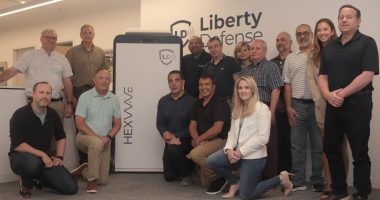Headquartered in Toronto with operations in the US, Singapore and China – Poet Technologies has created the first-ever wafer-level integration of electronics and photonics into a single device called the POET Optical Interposer. The Interposer achieves electronics and photonics integration with high-speed communication among all devices and allows for high-speed communication. The interposer is used in AI, the Internet of Things, autonomous vehicles and high-speed networking for cloud service providers and data centers.
Here with us today is the CFO and Executive Vice President of POET Technologies, Thomas Mika. Hello again, and welcome to The Market Herald.
TMH: Just to start off, what do you think makes POET a valuable investment?
TM: That’s an excellent question, but I have to apologize in advance that it’s a pretty long answer. Before I answer the question, I also have to invoke our safe harbour by reminding listeners that before they invest, they should read the risks that are detailed in our filings and on sedar.com and Canada sec.gov in the US.
So right now, POET’s technology is geared towards making the internet faster, which is a goal that I’m sure everyone understands and appreciates. The end users of our products are data center operators who not only want their data to be transmitted faster over fibre optic cables to your home, but they also want to do it using less power. POET’s products are able to accomplish both of these objectives, higher speed and lower power and more. The market for data center products, transceivers specifically, is almost $6 billion and growing to almost $10 billion in 2027.
So there’s a lot of competition in this market between now and 2027. There’s going to be a lot of retooling in these data centers. As the industry data transmission speeds increase and the energy budgets of the data center operators are stretched absolutely thin to the breaking point. We believe that POET’s technology will more easily enable data center operators to make this transition cost-effectively. It’s a complex calculation, but we believe we will be among only a handful of companies that actually help them to accomplish this task data centers are only the beginning of the use of our technology, as you mentioned in the introduction. Our optical interposer platform applies to almost any photonics application, from artificial intelligence and GPUs to satellite communications to biosensors and automotive lidar. These are enormous markets where scalability is the key to success. In other words, being able to increase the volumes of photonic devices produced while at the same time lowering cost and power requirements for any specific application. This is something that very few companies are able to achieve, and it’s the essential advantage that POET has built. That’s why I think POET is a valuable investment, not just for this year but for this decade and beyond.
TMH: What is the OFC Conference, when is it and what is the significance of the conference?
TM: OFC used to be called the Optical Fiber Conference. In fact, it may still be. It’s basically the premier event of Optica, which is the leading global society for optics and photonics. They sponsor conferences, exhibitions, seminars, and publications for scientists, engineers and business people around the world, and we’re really privileged at POET to have Professor Michal Lipson, the president of Optica, on POET’s Board of Directors. The conference and exhibition are held annually in San Diego, and this year the technical conference will begin on Sunday, March 5th, while the exhibition will start on Tuesday, March 7th, and both end on Thursday, March 9th. All of the major photonics companies, suppliers and customers will be there at that exhibition. POET will be exhibiting a range of products there. In fact, we’re doing live demonstrations of several optical engines on the cutting edge of photonics products, including our 800G receive engine that incorporates some key electronic components that increase performance and our LightBar products targeted at artificial intelligence machine learning accelerator chips.
Last year was the first time we exhibited at OFC with our products, I should say it was the first time we had products to exhibit at OFC, and it really increased our visibility in the industry. This year will showcase our optical engine chiplets. They’re so small that you can place three side by side on a US dime and still have room left over. The industry will be able to see from that how we can engineer transceivers of speeds of 800G, 1.6 terabytes and higher into standard pluggable form factors. So we’re exhibiting at Booth 5311. So if anyone is in the area, please register as a visitor to the exhibition and come see us there. Happy to show you around.
TMH: POET has succeeded in building traction so far in 2023 for its products — why has this happened, and how can it continue to build on the existing demand?
TM: Well, after six years of development, we showed our first products last March at OFC in China through our joint venture called Super Photonics. We’ve been working with several module makers who are designing our optical engines into their 100G and 200G transceiver modules, which we’re now calling sort of legacy modules, but this is really important for POET to demonstrate both technical and market acceptance of our technology. We’ve also been working on advanced, truly novel products like the ADVA Quattro, that’s multiple 400G engines in one module. There’s no other company in the world that could have done that module for ADVA, a transceiver device that helps data centers to continue to use their 100G Legacy ports while they upgrade their systems to 400G. We’re working with Lux Share Technologies, a giant company in China and a global leader in network equipment, to include POET design chiplets in 400G and 800G transceiver modules. We’ve also continued to work with Celestial AI, one of the most highly regarded and well-funded startup companies in the AIMO market, on a packaged light source for their chip. All of these products are in various stages of development and qualification, but we did announce that we had released four products into what we call released production earlier this year, and that means that once those products pass the qualification, we expect to receive orders for volume production this year.
TMH: POET has had some good releases over the last few weeks in terms of product and partnerships, can we expect this to be a consistent trend for 2023?
TM: Yes, definitely. We’ve said that we expect to release to production at least four additional products this year. We have some really important announcements coming up in the next few months, like our 800G transmit engine built with Lumentum lasers using two 400G chiplets that I mentioned over the course of this year. We’re going to combine the 800G transmit with the 800G receive that is in qualification now for a complete 800G solution. Now the market right now is looking at 800G for them to implement sometime in the next year or two. So that’s how far ahead of the curve you need to be when you’re presenting at a show like this or when you’re developing products. Also, we’re working on a very important thing that the industry has been talking about, which is to work on speeding up each channel.
So most of the high-speed transceivers today, these things that convert electronics into light and back operate at 100G per channel. Working with our partner Liobate, we expect to make progress on speeding the chips up even more, using what’s called a thin film lithium niobate modulator. Forget about the technology there, but really what’s going to happen is we’re going to be able, I think, sometime this year to demonstrate 200G per channel, and that’s a really important development. Now, niobate is one of those materials that have been around for a long time, and everybody recognizes its properties, but it’s been too bulking and too cumbersome to work with, but they’ve got a new version of it called Thin Film Version, and what’s really important for our interposer is the way that these new components and new materials can be shown to work and to communicate with the outside world. So it also is very important that we want to build up our capability to design and develop entire receiver modules, not just optical engines, and that would enable us to sell directly to end users, like network equipment companies and data center operators. So we’ll be making announcements throughout the year on both new products and new customers for our current products, including some announcements of revenue for both Super Photonics and POET.
Thanks for your time, Tom.
We have been speaking with Tom Mika, CFO and Executive Vice President of POET Technologies. For more information, go to poet-technologies.com or check out the TSXV, where you can find them under the ticker symbol ‘PTK’ and on the NASDAQ under POET.
A special thanks to you, our viewers, for joining us today. I’m Coreena Robertson, and this has been The Top Line.
FULL DISCLOSURE: This is a paid article produced by The Market Herald.



